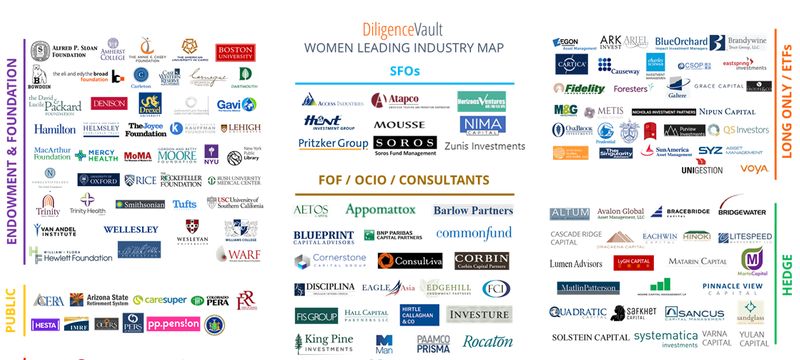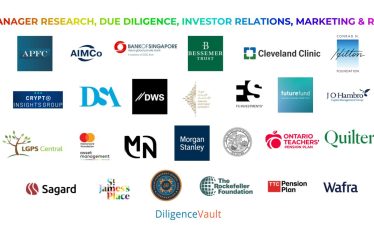As an entrepreneur at the intersection of Investment Management and Technology, I experienced unconscious gender biases when we started pitching the DiligenceVault platform to users and investors. Our ability to succeed despite these biases inspired this blog and research around women-led investment offices, asset managers, and InvestTech / AssetTech firms. It’s been both educational and inspiring to recognize and celebrate diverse risk takers who have shown extraordinary resilience in achieving success.
The map has one notable shortcoming in that various heads of groups within large platforms are playing the role of a CEO / CIO but are not included, simply because we do not have the transparency into the entities. Even so, it’s been an interesting exercise.
The map is power packed, and we had to shrink the logos to fit in one view. But then again, in such a big industry, why does this cohort fit on just one page? IT SHOULDN’T!
Women as Investment Leaders
- Investing for a cause: End investors / asset owners and intermediaries have more women succeeding into leadership than in the asset management function. In the asset owner space, Endowments & Foundations lead the way, as perhaps women are more drawn to the opportunity to give back, nurture, and invest for a cause.
- External biases: Why the drastic decline in women leaders when it comes to asset management? What externalities are at play in demonstrating skill and investment abilities? Further, the flow of capital is restricted to only a few asset managers. Self selection and work life balance is often mentioned as one of the root causes behind these statistics, but I personally know many very successful women business builders who are constantly on the road and are able to make their lives work!
- Sourcing pipeline: Another observation is that there are more women leaders in long only, followed by hedge, and then lastly drawdown structures. The conjecture is that public markets and HFs traditionally source people from sell side research and trading desks, which have increasingly integrated over the years. However, PE / VC / RE source talent from investment banking, which has been historically male dominated and largely continues to be.
- $$$ matter: Narrowing the scope further and specific to drawdown categories, more women have been successful as VCs, while we see limited presence in the PE / RE / Infrastructure segments. Again, asset base disadvantage limits further progress of women leaders into these segments. It is possible to be an early stage VC with $10mm fund, but you need a much bigger capital base for successful PE/RE investing.
Women as AssetTech / InvestTech Leaders
Technology is becoming an important differentiator and enabler of investment management – from front to back. Let’s look at women in AssetTech / InvestTech.
We presented at FinTech Sandbox Demo Day 5.0 last week, where out of 9 companies there was an almost equal mix of men- and women-led companies. Kudos to the Sandbox team who are bringing together diverse founders in defining industry tech!
Women as Buyers
Among our DiligenceVault clients, we see that women users generally conduct much more diligence on us than men. There’s no right or wrong about it. Men may have stronger conviction that they can make things work out, and there is tolerance for them if they make a mistake. It may be that the converse holds true for women, that there is not as great a support system to allow for a mistake if their choice were to be incorrect.
From a Page to a Book
There are notable industry and policy initiatives that continue to provide tailwind to transform – Girls Who Invest, 100 Women in Finance, MWBE programs, along with impact investing frameworks that encourage increasing diversity in investment management leadership.
In the asset owner / manager food chain, it’s the asset owners who are best positioned to demand change, to drive better and diversified return streams. All investment policy statements have prudent diversification criteria backed by years of empirical research. The first order and traditional diversification criteria depend on asset class characteristics built on factors such as liquidity, duration, sector, geography, strategy, and more…
Now there are tools and research that enable second order thinking in terms of diversification which is largely cognitive in nature.
An approach that breaks down homogeneous thinking and accounts for diversity in drawdown or loss experiences, education and investment training, research frameworks and biases of the individuals who invest.
So which cohort of asset owners will lead in the second order cognitive diversification in investing which would reflect greater gender diversity?
If you are interested in this topic, we’d like to hear from you. What are your thoughts and experiences? Who else should we add to our maps? Please email anna@diligencevault.com
Credit for the Women Leading Map: Many thanks to Alena Kuprevich, Amit Sinha, Angelique Sellers, Charlotte Beyer, Dom Negrotto, Jennifer DeSisto, Karyn Williams, Laxmi Ramanath, Marsha Roth, Marianne O, Nancy Wu, Sonali Dalal, Tanuja Pulakhandam & Team DiligenceVault for help with the map. However, views expressed are solely of the author.



